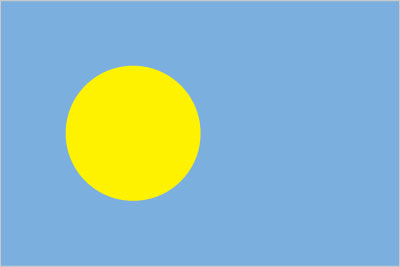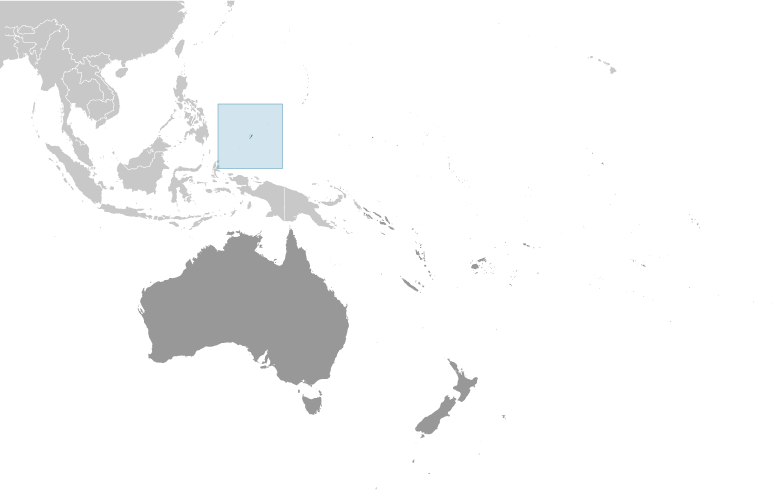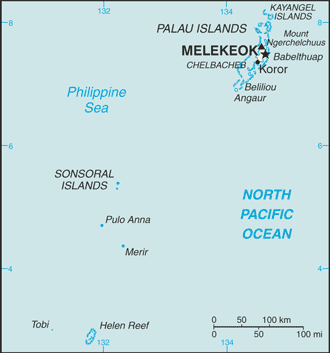



Australia-Oceania :: PALAU
- Hide
Introduction :: PALAU
Panel - Expanded -
After three decades as part of the UN Trust Territory of the Pacific under US administration, this westernmost cluster of the Caroline Islands opted for independence in 1978 rather than join the Federated States of Micronesia. A Compact of Free Association with the US was approved in 1986 but not ratified until 1993. It entered into force the following year when the islands gained independence.
- Hide
Geography :: PALAU
Panel - Expanded -
Oceania, group of islands in the North Pacific Ocean, southeast of the Philippines7 30 N, 134 30 EOceaniatotal: 459 sq kmland: 459 sq kmwater: 0 sq kmcountry comparison to the world: 198slightly more than 2.5 times the size of Washington, DC0 km1,519 kmterritorial sea: 3 nmexclusive fishing zone: 200 nmtropical; hot and humid; wet season May to Novembervarying topography from the high, mountainous main island of Babelthuap to low, coral islands usually fringed by large barrier reefslowest point: Pacific Ocean 0 mhighest point: Mount Ngerchelchuus 242 mforests, minerals (especially gold), marine products, deep-seabed mineralsagricultural land: 10.8%arable land 2.2%; permanent crops 4.3%; permanent pasture 4.3%forest: 87.6%other: 1.6% (2011 est.)NAtyphoons (June to December)inadequate facilities for disposal of solid waste; threats to the marine ecosystem from sand and coral dredging, illegal fishing practices, and overfishingparty to: Biodiversity, Climate Change, Climate Change-Kyoto Protocol, Desertification, Law of the Sea, Ozone Layer Protection, Wetlands, Whalingsigned, but not ratified: none of the selected agreementswesternmost archipelago in the Caroline chain, consists of six island groups totaling more than 300 islands; includes World War II battleground of Beliliou (Peleliu) and world-famous rock islands
- Hide
People and Society :: PALAU
Panel - Expanded -
noun: Palauan(s)adjective: PalauanPalauan (Micronesian with Malayan and Melanesian admixtures) 72.5%, Carolinian 1%, other Micronesian 2.4%, Filipino 16.3%, Chinese 1.6%, Vietnamese 1.6%, other Asian 3.4%, white 0.9%, other 0.3% (2005 est.)Palauan (official on most islands) 66.6%, Carolinian 0.7%, other Micronesian 0.7%, English (official) 15.5%, Filipino 10.8%, Chinese 1.8%, other Asian 2.6%, other 1.3%note: Sonsoral (Sonsoralese and English are official), Tobi (Tobi and English are official), and Angaur (Angaur, Japanese, and English are official) (2005 est.)Roman Catholic 49.4%, Protestant 30.9% (includes Protestant (general) 23.1%, Seventh Day Adventist 5.3%, and other Protestant 2.5%), Modekngei 8.7% (indigenous to Palau), Jehovah's Witnesses 1.1%, other 8.8%, none or unspecified 1.1% (2005 est.)21,265 (July 2015 est.)country comparison to the world: 2200-14 years: 20.26% (male 2,225/female 2,084)15-24 years: 17.18% (male 1,819/female 1,834)25-54 years: 46.21% (male 5,992/female 3,834)55-64 years: 9.03% (male 667/female 1,253)65 years and over: 7.32% (male 418/female 1,139) (2015 est.)total: 33 yearsmale: 32.5 yearsfemale: 34.2 years (2014 est.)0.38% (2015 est.)country comparison to the world: 16311.05 births/1,000 population (2015 est.)country comparison to the world: 1777.99 deaths/1,000 population (2015 est.)country comparison to the world: 1020.71 migrant(s)/1,000 population (2015 est.)country comparison to the world: 66urban population: 87.1% of total population (2015)rate of urbanization: 1.66% annual rate of change (2010-15 est.)MELEKEOK (capital) 299 (2012)at birth: 1.06 male(s)/female0-14 years: 1.07 male(s)/female15-24 years: 0.99 male(s)/female25-54 years: 1.56 male(s)/female55-64 years: 0.53 male(s)/female65 years and over: 0.37 male(s)/femaletotal population: 1.1 male(s)/female (2015 est.)total: 11.15 deaths/1,000 live birthsmale: 12.67 deaths/1,000 live birthsfemale: 9.53 deaths/1,000 live births (2015 est.)country comparison to the world: 130total population: 72.87 yearsmale: 69.69 yearsfemale: 76.23 years (2015 est.)country comparison to the world: 1331.71 children born/woman (2015 est.)country comparison to the world: 1709.9% of GDP (2013)country comparison to the world: 281.38 physicians/1,000 population (2010)4.8 beds/1,000 population (2010)improved:urban: 97% of populationrural: 86% of populationtotal: 95.3% of populationunimproved:urban: 3% of populationrural: 14% of populationtotal: 4.7% of population (2011 est.)improved:urban: 100% of populationrural: 100% of populationtotal: 100% of populationunimproved:urban: 0% of populationrural: 0% of populationtotal: 0% of population (2015 est.)NANANA47.1% (2014)country comparison to the world: 7definition: age 15 and over can read and writetotal population: 99.5%male: 99.5%female: 99.6% (2015 est.)total: 14 yearsmale: 14 yearsfemale: 14 years (2013)
- Hide
Government :: PALAU
Panel - Expanded -
conventional long form: Republic of Palauconventional short form: Palaulocal long form: Beluu er a Belaulocal short form: Belauformer: Trust Territory of the Pacific Islands, Palau Districtconstitutional government in free association with the US; the Compact of Free Association entered into force on 1 October 1994name: Melekeokgeographic coordinates: 7 29 N, 134 38 Etime difference: UTC+9 (14 hours ahead of Washington, DC, during Standard Time)16 states; Aimeliik, Airai, Angaur, Hatohobei, Kayangel, Koror, Melekeok, Ngaraard, Ngarchelong, Ngardmau, Ngatpang, Ngchesar, Ngeremlengui, Ngiwal, Peleliu, Sonsorol1 October 1994 (from the US-administered UN trusteeship)Constitution Day, 9 July (1979), day of a national referendum to pass the new constitutionratified 9 July 1980, effective 1 January 1981; amended 1992, 2004 (2011)mixed legal system of civil, common, and customary lawhas not submitted an ICJ jurisdiction declaration; non-party state to the ICCt18 years of age; universalchief of state: President Tommy REMENGESAU (since 17 January 2013); Vice President Antonio BELLS (since 17 January 2013); note - the president is both chief of state and head of governmenthead of government: President Tommy REMENGESAU (since 17 January 2013); Vice President Antonio BELLS (since 17 January 2013)cabinet: Cabinet appointed by the president with the advice and consent of the Senate; also includes the vice president; the Council of Chiefs consists of chiefs from each of the states who advise the president on issues concerning traditional laws, customs, and their relationship to the constitution and laws of Palauelections/appointments: president and vice president directly elected on separate ballots by absolute majority popular vote in 2 rounds if needed for a 4-year term (eligible for a second term); election last held on 6 November 2012 (next to be held in November 2016)election results: Tommy REMENGESAU elected president; percent of vote - Tommy REMENGESAU 58%, Johnson TORIBIONG 42%; Antonio BELLS elected vice presidentdescription: bicameral National Congress or Olbiil Era Kelulau consists of the Senate (9 seats; members directly elected in single-seat constituencies by majority vote to serve 4-year terms) and the House of Delegates (16 seats; members directly elected in single-seat constituencies by simple majority vote to serve 4-year terms)elections: Senate - last held on 6 November 2012 (next to be held in November 2016); House of Delegates - last held on 6 November 2012 (next to be held in November 2016)election results: Senate - percent of vote - NA; seats - independents 9; House of Delegates - percent of vote - NA; seats - independents 16highest court(s): Supreme Court (consists of the chief justice and 3 associate justices organized into appellate trial divisions; also within the Supreme Court organization are the Common Pleas and Land Courts)judge selection and term of office: justices nominated by a 7-member independent body consisting of judges, presidential appointees, and lawyers, and appointed by the president; judges appointed until mandatory retirement at age 65subordinate courts: National Court and other 'inferior' courtsnoneNAACP, ADB, AOSIS, FAO, IAEA, IBRD, ICAO, ICRM, IDA, IFC, IFRCS, ILO, IMF, IMO, IMSO, IOC, IPU, MIGA, OPCW, PIF, Sparteca, SPC, UN, UNAMID, UNCTAD, UNESCO, WHOchief of mission: Ambassador Hersey KYOTA (since 12 November 1997)chancery: 1701 Pennsylvania Avenue NW, Suite 300, Washington, DC 20036telephone: [1] (202) 452-6814FAX: [1] (202) 452-6281consulate(s): Tamuning (Guam)chief of mission: Ambassador Helen P. REED-ROWE (since 27 September 2013)embassy: Koror (no street address)mailing address: P. O. Box 6028, Koror, Republic of Palau 96940telephone: [680] 587-2920FAX: [680] 587-2911light blue with a large yellow disk shifted slightly to the hoist side; the blue color represents the ocean, the disk represents the moon; Palauans consider the full moon to be the optimum time for human activity; it is also considered a symbol of peace, love, and tranquilitybai (native meeting house); national colors: blue, yellowname: "Belau rekid" (Our Palau)lyrics/music: multiple/Ymesei O. EZEKIELnote: adopted 1980
- Hide
Economy :: PALAU
Panel - Expanded -
The economy consists of tourism and other services such as trade, subsistence agriculture, and fishing. Government is a major employer of the work force relying on financial assistance from the US under the Compact of Free Association (Compact) with the US. The Compact took effect, after the end of the UN trusteeship on 1 October 1994. The US provided Palau with roughly $700 million in aid for the first 15 years following commencement of the Compact in 1994 in return for unrestricted access to its land and waterways for strategic purposes. Business and leisure tourist arrivals numbered over 125,000 in fiscal year 2014, a 13.4% increase over the previous year. The population enjoys a per capita income roughly double that of the Philippines and much of Micronesia. Long-run prospects for tourism have been bolstered by the expansion of air travel in the Pacific, the rising prosperity of industrial East Asia, and the willingness of foreigners to finance infrastructure development. Proximity to Guam, the region's major destination for tourists from East Asia, and a regionally competitive tourist infrastructure enhance Palau's advantage as a destination.$288 million (2014 est.)$266.8 million (2013 est.)$267.4 million (2012 est.)note: GDP estimate includes US subsidycountry comparison to the world: 217$269 million (2014 est.)8% (2014 est.)-2% (2013 est.)4.6% (2012 est.)country comparison to the world: 157$16,300 (2014 est.)$15,100 (2013 est.)$15,100 (2012 est.)country comparison to the world: 102agriculture: 3.2%industry: 20%services: 76.8% (2012 est.)coconuts, copra, cassava (manioc, tapioca), sweet potatoes; fishtourism, craft items (from shell, wood, pearls), construction, garment makingNA%10,470 (2014)country comparison to the world: 217agriculture: 20%industry: NA%services: NA% (1990)4.2% (2005 est.)country comparison to the world: 39NA%lowest 10%: NA%highest 10%: NA%revenues: $123.6 millionexpenditures: $97.53 million (2012 est.)19% of GDP (2012 est.)country comparison to the world: 674% of GDP (2012 est.)country comparison to the world: 841 October - 30 September4% (2014 est.)2.8% (2013 est.)country comparison to the world: 157$NA-$28 million (2014 est.)-$19.9 million (2013)country comparison to the world: 65$19.1 million (2014 est.)$14.4 million (2013 est.)country comparison to the world: 212shellfish, tuna, copra, garments$177.7 million (2014 est.)$146.5 million (2013 est.)country comparison to the world: 212machinery and equipment, fuels, metals; foodstuffs$67 million (2014)$65 million (2013)country comparison to the world: 202the US dollar is used
- Hide
Communications :: PALAU
Panel - Expanded -
total subscriptions: 7,100subscriptions per 100 inhabitants: 34 (2014 est.)country comparison to the world: 203total: 19,100subscriptions per 100 inhabitants: 90 (2014 est.)country comparison to the world: 210domestic: fixed-line and mobile-cellular services available with a combined subscribership of roughly 100 per 100 personsinternational: country code - 680; satellite earth station - 1 Intelsat (Pacific Ocean) (2009)no TV stations; a cable TV network covers the major islands and provides access to rebroadcasts, on a delayed basis, of a number of US stations, as well as access to a number of real-time satellite TV channels; about a half dozen radio stations (1 government-owned) (2009)AM 1, FM 4, shortwave 1 (2001)1 (cable) (2005).pw
- Hide
Transportation :: PALAU
Panel - Expanded -
3 (2013)country comparison to the world: 194total: 11,524 to 2,437 m: 1 (2013)total: 21,524 to 2,437 m: 2 (2013)major seaport(s): Koror
- Hide
Military :: PALAU
Panel - Expanded -
no regular military forces; Palau National Police (2009)males age 16-49: 6,987 (2010 est.)males age 16-49: 5,272females age 16-49: 3,969 (2010 est.)male: 216female: 222 (2010 est.)defense is the responsibility of the US; under a Compact of Free Association between Palau and the US, the US military is granted access to the islands for 50 years, but it has not stationed any military forces there (2008)
- Hide
Transnational Issues :: PALAU
Panel - Expanded -
maritime delineation negotiations continue with Philippines, Indonesia
